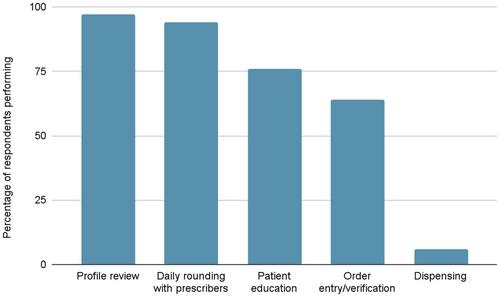Nationwide evaluation of the clinical impact of acute care adult medicine pharmacists
Abstract
Introduction
The impact of pharmacists has been described for many practice areas including critical care, emergency medicine, and transitions of care. Literature describing the extensive role of adult medicine (AMED) clinical pharmacists in the inpatient setting is limited.
Objective
The objective of this study was to characterize clinical activities performed by inpatient AMED pharmacists nationally.
Methods
This was a multicenter, prospective, observational study including AMED pharmacists who spend more than 50% of their time practicing in the acute care setting. A 65-item electronic survey was developed and distributed to members of the American College of Clinical Pharmacy AMED Practice and Research Network (PRN). The survey collected demographics, clinical interventions, rates of intervention acceptance, and the significance of those interventions, where applicable. Respondents were asked to report all interventions made over any one-week period while providing direct patient care. Descriptive statistics were used to summarize data. Chi-square tests and Wilcoxon rank sum tests were used to compare nominal and continuous data, respectively.
Results
Thirty three pharmacists representing 988.5 h of direct patient care reported activities, including profile review (97%), daily rounding with prescribers (94%), patient education (76%), and order entry or verification (64%). During the study period, 4488 interventions were documented. The most common interventions and activities documented were optimization of therapy (n = 1125, 25%), initiation of therapy (n = 770, 17%), and interpretation of diagnostic data or lab values (n = 331, 7%). The top three therapeutic classes with interventions were antimicrobials (n = 473, 25%), cardiovascular medications (n = 248, 13%), and antithrombotics (n = 190, 10%). Of the applicable interventions, 2775 (89%) were accepted, 2541 (81%) were pharmacist-initiated, and 277 (9%) were classified as serious or very/extremely significant interventions.
Conclusion
AMED pharmacists provide diverse recommendations across numerous medication therapeutic categories that are highly accepted. AMED pharmacists play an important role in optimizing medication use through care team and patient interactions.


 求助内容:
求助内容: 应助结果提醒方式:
应助结果提醒方式:


